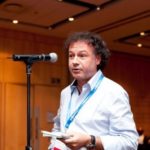Link to Pubmed [PMID] – 7917428
FEMS Microbiol Rev 1994 Aug; 14(4): 405-14
Alcaligenes eutrophus CH34 is the main representative of a group of strongly related strains (mostly facultative chemolithotrophs) that are well adapted to environments containing high levels of heavy metals. It harbors the megaplasmids pMOL28 and pMOL30 which carry resistance determinants to Co2+, Ni2+, CrO(4)2-, Hg2+, Tl+, Cd2+, Cu2+ and Zn2+. Among the best characterized determinants are the cnr operon (resistance to Co, Ni) on pMOL28 and the czc operon on pMOL30 (resistance to Co, Cd and Zn). Although the two systems reveal a significant degree of amino acid similarity in the structural genes, the regulation of the operons is different. The resistance mechanism in both cases is based on efflux. The efflux mechanism leads to a pH increase outside of the cytoplasmic membrane. Metals are sequestered from the external medium through the bioprecipitation of metal carbonates formed in the saturated zone around the cell. This latter phenomenon can be exploited in bioreactors designed to remove metals from effluents. The bacteria are immobilized on composite membranes in a continuous tubular membrane reactor (CTMR). The effluent continuously circulates through the intertubular space, while the external surface of the tubes is in contact with the growth medium. Metal crystals are eventually removed by the effluent stream and collected on a glass bead column. The system has been applied to effluents containing Cd, Zn, Co, Ni and Cu. By introducing catabolic plasmids involved in the aerobic degradation of PCBs and 2,4-D into metal-resistant A. eutrophus strains, the application range was widened to include effluents polluted with both organic and inorganic substances. Biosensors have been developed which are based on the fusion of genes induced by metals to a reporter system, the lux operon of Vibrio fischeri. Bacterial luciferases produce light through the oxidation of fatty aldehydes. The gene fusions are useful both for the study of regulatory genes and for the determination of heavy metal concentrations in the environment.

